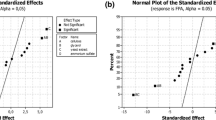Abstract
A low-foaming hydrophobin II deletant of the Trichoderma reesei strain Rut-C30 was used for production of cellulases by continuous cultivation on lactose medium in a laboratory fermenter. The control paradigm of the addition of new medium to the continuous process was based on the growth dynamics of the fungus. A decrease in the rate of base addition to the cultivation for pH-minimum control was used as an indicator of imminent exhaustion of carbon source for growth and enzyme induction. When the amount of base added per 5 min computation cycle decreased below a given value, new medium was added to the fermenter. When base addition for pH control thereafter increased above the criterion value, due to increased growth, the medium feed was discontinued or decreased. The medium feeding protocol employed was successful in locking the fungus in the stage of imminent, but not actual, exhaustion of carbon source. According to the results of a batch cultivation of the same strain on the same medium, this is the phase of maximal enzyme productivity. The medium addition protocol used in this work resulted in a very stable continuous process, in which cellulase productivity was maintained for several hundred hours at the maximum level observed in a batch cultivation for only about 10 h. Despite a major technical disturbance after about 420 h, the process was restored to stability. When the cultivation was terminated after 650 h, the level of enzyme production was still maximal, with no signs of instability of the process.




Similar content being viewed by others
References
Bailey MJ, Viikari L (1993) Production of xylanases by Aspergillus fumigatus and Aspergillus oryzae on xylan-based media. World J Microbiol Biotechnol 9:80–84
Bailey MJ, Askolin S, Hörhammer N, Tenkanen M, Linder M, Penttilä M, Nakari-Setälä T (2002) Process technological effects of deletion and amplification of hydrophobins I and II in transformants of Trichoderma reesei. Appl Microbiol Biotechnol 58:721–727
IUPAC (International Union of Pure and Applied Chemistry) (1987) Measurement of cellulase activities. Pure Appl Chem 59:257–268
Lowry OH, Rosebrough NJ, Farr AL, Randall RJ (1951) Protein measurement with the Folin phenol reagent. J Biol Chem 193:265–275
Mandels M, Weber J (1969) The production of cellulases. Adv Chem Ser 95:391–414
Montenecourt BS, Eveleigh DE (1979) Selective screening methods for the isolation of high-yielding cellulase mutants of Trichoderma reesei. Adv Chem Ser 181:289–301
Nakari-Setälä T, Penttilä M, Bailey M, Tenkanen M (2002) Improved biotechnical production method (Parannettu biotekninen tuotantomenetelmä). Finnish Patent 108863 (in Finnish)
Reinikainen T (1994) The cellulose-binding domain of cellobiohydrolase I from Trichoderma reesei. VTT Publications 206, VTT, PO Box 2000, 02044 VTT, Finland
van Tilbeurgh H, Claeyssens M (1985) Detection and differentiation of cellulase components using low molecular mass fluorogenic substrates. FEBS Lett 187:283–288
van Tilbeurgh H, Claeyssens M, De Bruyne CK (1982) The use of 4-methylumbelliferyl and other chromophoric glycosides in the study of cellulolytic enzymes. FEBS Lett 149:152–156
van Tilbeurgh H, Loontiens FG, De Bruyne CK, Claeyssens M (1988) Fluorogenic and chromogenic glycosides as substrates and ligands of carbohydrases. Methods Enzymol 160:45–59
Tolan JS, Foody B (1999) Cellulase from submerged fermentations. Adv Biochem Eng Biotechnol 65:41–67
Acknowlegements
The authors thank Helena Nevalainen (Macquarie University, Sydney, Australia) for comments on an earlier draft of the manuscript. We are grateful to Tarja Hakkarainen for excellent technical assistance and particularly for unfailing proficiency in aseptic technique.
Author information
Authors and Affiliations
Corresponding author
Rights and permissions
About this article
Cite this article
Bailey, M.J., Tähtiharju, J. Efficient cellulase production by Trichoderma reesei in continuous cultivation on lactose medium with a computer-controlled feeding strategy. Appl Microbiol Biotechnol 62, 156–162 (2003). https://doi.org/10.1007/s00253-003-1276-9
Received:
Revised:
Accepted:
Published:
Issue Date:
DOI: https://doi.org/10.1007/s00253-003-1276-9




